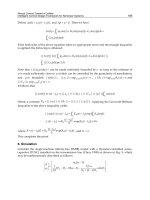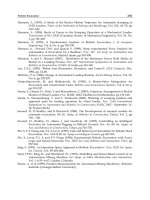Tribology in Machine Design 2009 Part 11 pdf
Bạn đang xem bản rút gọn của tài liệu. Xem và tải ngay bản đầy đủ của tài liệu tại đây (500.06 KB, 11 trang )
288
Tribology
in
machine design
Assuming
further
that there
is a
parabolic distribution
of the
velocity within
the oil film
the final
form
of eqn
(8.15)
is
In
order
to
derive
the
expression
for the
maximum velocity
of the oil due to
the
action
of
centrifugal
force,
we
assume
that
the
tooth
is
immersed
in the
oil
bath,
x
e
=0.2m,
below
the
dedendum
and
that
the
time
of
action
of the
centrifugal
force
is
defined
by the
angle
of
rotating,
a, and the
angular
velocity,
co;
thus,
and finally
Substituting
eqn
(8.18) into
eqn
(8.17)
and
rearranging gives
where
v is the
kinematic viscosity
in
cSt.
According
to eqn
(8.19)
the
allowable value
of the
pitch line velocity,
F,,
at
which splash lubrication
is
still
effective,
is a
function
of the oil
viscosity,
the
module,
the
angle between
the
point
of
immersion
and the
point
of
engagement,
a,
and, indirectly,
the
surface roughness
of the
tooth
surface.
Gear
trains operating
at
high speeds
and
also
power gear units
are jet
lubricated. Each pair
of
meshing gears should receive
an
amount
of oil
resulting
from
the
expression
where
Q
is the flow
rate
of oil per 1 cm of the
tooth width, measured
in
[m
3
/(min
cm)],
m
is the
module
in mm and V is the
pitch line velocity
in
ms"
1
.
For a
very approximate estimate
of the oil flow
rate required,
the
following
formula
can be
used:
where
N
is the
power transmitted
in kW.
8.8.
Efficiency
of
gears
The
power loss
in
properly lubricated spur, helical
or
similar types
of
gearing
is
usually very low, that
is due to the
tooth
friction
being
of the
Lubrication
and
efficiency
of
involute gears
289
order
of
only
1 per
cent
or
less
of the
power transmitted
at
full
load.
To
this,
the
losses
due to oil
churning
and
bearing
friction
have
to be
added.
In
such
gears, there
is
inevitably, sliding
at all
points
in the
path
of
contact, except
at
the
pitch point,
and it can be
deduced that
the
coefficient
of
friction
is low
and
that lubrication must therefore
be
effective
in
spite
of the
extremely
high
contact pressures.
In the
case
of
skew,
and
more particularly worm, gearing, sliding occurs
not
only
as in
spur gears but, much more importantly,
in a
direction
at
right
angles
to
this.
In
fact,
we can
obtain
a
sufficiently
close approximation
to
the
situation
in a
worm gear
by
ignoring
the
pressure angle
of the
thread
and
thinking
of
this
thread
as
perpendicular
to the
axis.
We can
then
regard
the
thread
as an
inclined plane which moves relatively
to the
surface
of the
worm
wheel;
and the
analogous situation
of a
block being pushed
up an
inclined
plane
by a
horizontal
force
is
quite common
in
mechanics. Thus,
the
expression
for
efficiency
can be
written
as
where
a is the
inclination
of the
plane,
or in
this case
the
pitch angle
of the
worm,
and
(j>
is the
angle
of
friction.
For the
case
of the
worm-wheel driving
the
worm
the
expression
for
efficiency
is
Now,
in the
case
of a
single-tooth worm,
a may be
only
a
few
degrees,
and if
the
surfaces
are dry or
poorly lubricated
^
may
well
exceed
a;
in
this case
rj
will
be
less than
0.5 and
r\'
will
be
negative.
In
other words,
the
drive
will
be
irreversible. Such
a
gear
has its
uses,
but
would
be
unthinkable
for
power
transmission.
For
multi-start worm gears, however,
a can be
made
of the
order
of
45°,
and
if
the
gears
are
well lubricated,
0,
under running conditions,
particularly
at
high speeds,
may
well
be of the
order
of 1° or
less.
The
efficiency
is
then
of the
order
0.97-0.98,
i.e.
of the
same
order
as
that
for
spur
gears.
As far as
power loss
is
concerned,
the
difference
is
probably negligible
but
it
should
be
noted that
the
losses have
to be
dissipated
as
heat,
and
since
the
amount
of
heat which
has to be
expended
is
almost directly
propor-
tional
to the
effective
coefficient
of
friction,
it is
vital
to
ensure that
the
best
possible lubrication
is
maintained,
and in the
case
of
highly
loaded gears
that
sufficient
cooling
is
provided.
8.8.1.
Analysis
of
friction
losses
In
Fig. 8.7,
one
gear rotating clockwise drives another. Subscript
1 is
used
on the
symbols
for the
driver
and the
subscript
2 is
used
on
those
for the
driven
gear.
All the
parameters used
in the
following
analysis
are
clearly
defined
in
Fig. 8.7. Using
the
assumption that when
two or
more pairs
of
teeth
carry
the
load simultaneously,
the
normal pressure
is
shared equally
290
Tribology
in
machine design
between them,
it can be
shown that
the
total
friction
loss
and the
power
input
to the
driven gear during
the
engagement
of one
pair
of
mating teeth
are the
same
as
when
one
pair
of
mating teeth carry
the
entire load
throughout their period
of
engagement.
During approach, considering
any
position
of
contact
as at x
(see Fig.
8.7),
the
normal force
W
opposes
the
rotation
of the
driver,
while
the
frictional
force
(fW)
assists rotation.
The
torque exerted
by the
driver
at
any
approach position
is as
follows:
but
thus
Figure
8.7
The
work output
for the
driver during approach
is as
follows
During recess,
the
direction
of
sliding between
the
teeth
is
reversed,
so
that
and the
work output
for the
driver during recess
Now, turning
to the
driven gear, during approach
the
normal
force
and the
frictional
force
oppose
one
another. Thus
Expressing
the
work output
for the
driven gear during approach
is
given
by
During recess, both
the
normal
force
and the
tangential
force
assist
the
rotation
of the
driven gear, therefore
but
Lubrication
and
efficiency
of
involute
gears
291
Case
I:
The
coefficient
of
friction
is
constant
The first
case
to be
considered
is
that
of the
constant
friction
coefficient
throughout
the
engagement. Integrating
the
equations describing
the
work
output,
gives
The
efficiency
of the
gears
is
therefore
equal
to
where
i is the
gear ratio.
The
friction
losses
per
minute
are
equal
to
The
efficiency
can be
written more simply
and
almost exactly
by
considering
the
work input
to be
equal
to
hence
292
Tribology
in
machine design
Cose
II. The
coefficient
of
friction
considered
as
variable
As
a
matter
of
fact,
the
friction
coefficient
is not
constant
but
varies
with
different
loads,
speeds,
lubricants
and
gear materials,
as
well
as
with
different
types
of
types
of
surface
finish and
many other factors. Actual tests
carried
out on
gears have revealed that
the
form
of the
relationship between
the
average
friction
coefficients
and the
pitch line velocities
is
very much
the
same
as in the
case
of
journal bearings.
At low
speeds,
the
values
of the
friction
coefficient
are
high, decreasing rapidly
to a
certain minimum value
with
increasing velocity,
and
then rising slowly with
further
increase
in
velocity.
There
is,
however,
one
important difference
in the
lubrication
mechanism
operating
in
plain journal bearings
and in
gears.
In the
case
of
the
journal bearings, hydrodynamic lubrication
is
usually
a
dominant type
of
lubrication while
in
gears, elastohydrodynamic lubrication
is the
main
mechanism.
It is
known that
the
nature
of
sliding between involute gear
teeth
consists
of
sliding
in one
direction during
approach,
reducing
to
zero
at the
pitch point where
the
direction
of
sliding changes,
and
increasing
again
as the
contact progresses through
the
recess action. This
is
shown,
in a
schematic way,
in
Fig. 8.8.
Since
the
direction
of
sliding changes
at the
pitch point,
we may
conclude
that
the
coefficient
of
friction
will
assume
the
value characteristic
for a
thick
Figure
8.8
Lubrication
and
efficiency
of
involute gears
293
film
lubrication
regime during
the
period
of
engagement
of a
pair
of
mating
teeth.
It is
possible
to set up an
efficiency
equation
in
various ways.
The
chances are, however, that
the
most that
can be
determined
by
experiment
is
to
establish some average values
of
friction
coefficient
for the
approach
action
and
similarly
for the
recess action.
Experimental
results suggest that
at
very
low
pitch
line
velocities
(up to
1.5
m
min~
1
)
the
friction
of
approach period appears
to be
approximately
double that
of the
recess period
on
hobbed, milled
and
shaped gears made
of
cast-iron,
soft-steel,
bronze
and
aluminium.
On
hardened
and
ground
steel gears, however,
the
difference
between
the
friction
of
approach
and the
friction
of
recess
is
almost non-existent. When
the
contact passes through
the
pitch point,
a
significant increase
in
friction
(about
150 per
cent) takes
place. Thus, introducing
different
average values
for the
friction
coefficients
of
the
approach
and
recess,
gives
8.8.2.
Summary
of
efficiency formulae
In
order
to
collate
the
material presented
in the
previous section
the
following
summary
is
made:
when
N
l5
N
2
is the
number
of
teeth
on
driver
and
driven gear, respectively,
i is the
gear ratio,
/?
a
,
/?
r
is the arc of
approach
and
recess
on the
driver, respectively,/is
the
average
coefficient
of
friction,/
a
is
the
average
coefficient
of
friction
during
the
approach period
and/
r
is the
294
Tribology
in
machine
design
average
coefficient
of
friction
during
the
recess
period,
then,
for the
constant
friction coefficient
and for
different
average
friction coefficients
during
the
approach
and
recess
periods
References
tO
Chapter
8 1. H. M.
Martin. Lubrication
of
gear
teeth.
Engineering,
102,
(1916),
16-19.
2.
D. W.
Dudley. Practical Gear Design.
New
York: McGraw-Hill, 1954.
3.
K. F.
Martin.
The
efficiency
of
involute
spur gears.
ASME
Technical Paper,
No.
80-C2/DET-16,
1980.
4.
D. W.
Dudley. Gear Handbook.
New
York: McGraw-Hill, 1962.
5.
D.
Dowson
and G. R.
Higginson.
A
Theory
of
Involute Gear Lubrication.
Gear
Lubrication
Symposium. London:
Inst.
of
Petroleum, 1964.
6.
D. W.
Dudley. Information sheet
Gear
scoring design guide
for
aerospace
spur
and
helical power gears. Washington,
D.C.:
AGMA,
1965.
7.
H.
Blok.
The
postulate about
the
constancy
of
scoring temperature.
Inter-
disciplinary
Approach
to the
Lubrication
of
Concentrated
Contacts,
NASA
SP-
237,
1970.
Index
Abrasive
wear,
19, 20
Concave surface,
67
Acoustic
emission,
268
Concentrated force,
65
Addendum,
10
Cone clutch,
114
Adhesive
interaction,
15
Conformal surfaces,
2
Adhesive junction,
14, 15
Conjunction
temperature,
75
Adhesive
wear,
19
Connecting-rod bearing,
213
Adhesive
wear equation,
39
Contact
mechanics,
64
Aerosol lubrication,
264
Convex surface,
67
Angle
of
lap, 129,
133
Copper-lead alloy,
221
Apparent area
of
contact,
14
Cornering
of
tyre,
152
Asperity,
14
Counterformal surfaces,
2
Attitude
angle,
192
Crankshaft bearing,
213
Attitude
of
journal,
57
Creep
of
tyre,
152
Axially
loaded bearing,
123
Critical slope,
188
Critical temperature,
82, 280
Ball
bearing,
7
Critical temperature hypothesis,
11
Band
and
block brake,
144
Curvature factor,
281
Band
brake,
136
Curved brake block,
138
Basic
dynamic capacity,
7
Cylinder liner,
8
Bearing
clearance,
54
Bearing
eccentricity,
54
Dedendum,
10
Bearing
materials,
220
Deformations
in
rolling-contact
Belt
drive,
128
bearing,
254
Belt
power transmission rating,
132
Diametral clearance, 190,
195
Big-end
bearing,
213
Differential
sliding,
249
Blistering,
167
Distributed force,
65
Blok
theory,
75, 280
Driven rolling,
156
Boundary
lubricated bearing,
121
Dynamic hydroplaning,
158
Brake
design,
136
Dynamically loaded journal bearing,
Braking
of
vehicle,
145 212
Bulk
temperature,
79
Eccentricity ratio, 190, 192,
203
Cam,
9
Efficiency
of
involute
gears,
273,
288
Cam-follower,
9, 246
Elastic contact,
14
Centrifugal
clutch,
120
Elastic extension
of
belt,
131
Chemical
wear,
19
Elastic hysteresis,
251
Coefficient
of
adhesion,
146
Elasticity
parameter,
241
Coefficient
of
viscosity,
48
Elastohydrodynamic lubrication,
3
Collar bearing,
124
Elliptical
bearing,
206
296
Index
Energy dissipation, 18
Engineering design,
1
Equivalent cylinder, 95
Equivalent speed method, 214
Extreme pressure oil,
11
Externally pressurized bearing,
18
1
Fatigue wear equation, 40
Film lubrication, 48
Flash temperature, 75, 83, 280
Flat pivot, 184
Fleming-Suh model, 45
Fluid film, 3, 6, 210
Four lobe bearing, 206
Fractional film defect, 34
Fracture mechanics and wear, 45
Fracture of adhesive junction, 16
Fracture toughness, 17
Free rolling, 156
Friction angle, 98
Friction circle, 122
Friction coefficient, 13
Friction drive, 10, 127
Friction due to adhesion, 15
Friction due to deformation, 17
Friction due to ploughing, 16
Friction in slideways, 98
Friction losses, 289
Friction stability, 100
Friction torque, 249
Frictional force, 13
Frictional traction. 10
Gas bearing, 210
Gear lubrication, 286
Gear tribodesign, 273
Gear wear, 285
Grease lubrication, 26
1
Grubin approximation, 245
Gyroscopic spin, 250
Heat of adsorption
of
lubricant, 35
Helical seal, 163
Hertzian area, 2
Hertzian stress, 9
Higher kinematic pair, 232
Hydrodynamically lubricated bearing,
Hydrostatic bearing, 178
Hydrostatic thrust bearing, 225
Hypoid gears, 11
174, 204
Hysteresis losses, 234
Hysteresis loss factor, 234
Inlet zone temperature, 244
Interfacial adhesive bonds, 15
Interfacial shear strength, 16
Involute gears, 10, 273
Jet lubrication, 262
Journal bearing, 189, 204
Journal bearing with:
fixed non-preloaded pads, 205
fixed preloaded pads, 205
movable pads, 207
special geometric features, 207
Junction growth, 15
Kinematics of rolling-contact bearing,
Kinetic friction, 98
Kingsbury, 186
256
Labyrinth seals, 164
Lambda ratio, 26, 29, 260, 265, 281
Line contact, 242
L life, 7, 267
Load bearing capacity, 196
Load number, 197, 215
Load sharing, 37
Load transmission,
1
Loading factor, 282
Lower kinematic pair, 97
Lubricant contamination, 266
Lubricant factor, 28
1
Lubricant filtration, 266
Lubricant viscosity, 33
Lubricated contact,
3
1
Lubrication effect on fatigue life, 265
Lubrication
of
cylinders, 238
Lubrication
of
rolling-contact
Lubrication of seals, 172
Lubrication of involute gears, 273
Lubrication regimes, 275
bearings, 259
Marangoni effect, 162
Mechanical seal, 160
Michell, 186
Michell bearing, 223
Micro-slip, 236
Misalignment, 6
Mist lubrication, 264
Index
297
Nonconforming contact, 22
Ocvirk number, 197
Ocvirk solution, 19
1
Offset factor, 206, 207
Oil film thickness, 214
Oil
flow,
194
Pad pivot, 207
Palmgren, 255
Peclet number, 76
Petroff law,
50
Piston,
8
Piston ring,
8
Pitting,
10,
12, 72, 282
Pivot bearing, 124
Plastic deformation, 15
Plasticity index, 14, 30
Plate clutch,
11
1
Ploughing, 14
Pneumatic tyres,
1
5
1
Point-contact lubrication, 245
Preload factor, 206, 208
Pressure gradient, I75
Pressure-viscosity coefficient, 33, 241,
Propulsion of vehicle, 145
Protective layer, 4
PV limit, 230
242, 281
Radial clearance, 190
Rayleigh step, 163
Real area of contact, 14
Recess,
180
Reynolds equation, 174, 177, 239
Reynolds hypothesis, 249
Reynolds number, 163, 238
Reynolds theory,
51
Rim clutch,
116
Roller bearing, 7
Rolling contact bearing, 7, 248
Rolling friction, 235, 248
Rolling
of
tyre,
155
Rope drive, 134
Run-in,
11
Screw jack,
105
Scuffing,
9,
11, 12, 278
Self-lubricating bearing, 226
Short-bearing approximation, 19
1
Short-bearing theory, 203
Sliding bearing, 6, 174
Sliding of tyre, 155
Solid film lubrication, 260
Sommerfeld diagram, 60
Sommerfeld number, 2
15
Sommerfeld solution, 190
Square thread, 103
Squeeze-film lubrication,
18
I
Standard deviation, 27
Static load rating, 7
Subcase fatigue, 73
Subsurface fatigue,
11
Surface active additives, 12
Surface failure, 71, 265
Surface fatigue, 73
Surface fatigue wear, 19,
21
Surface finish,
9
Surface peak,
90
Surface roughness, 2
Surface temperature, 74
Surface tension, 162, 240
Surface topography, 14
Surface traction, 233
Taper rolling bearing, 7
Thermal bulging,
80
Thermal correction factor, 244
Thermal effects, 74
Thermal loading factor, 244
Three lobe bearing, 206
Thrust bearing, 183, 221
Tilting pad bearing, 207, 223
Tin-aluminium alloy, 220
Traction effort, 146
Tractive resistance,
150
Tread pattern,
155
Triangular thread, 109
Tribodesign, 1
Tribology, 1
Tyre performance, 157
Tyre surface, 154
Unloaded bearing, 53
Variance, 27
V-belt drive, 134
Velocity factor, 282
Virtual coefficient of friction, 59
Viscosity,
180,
202, 204, 21
5
Viscosity parameter, 241
Viscosity-temperature coefficient,
245
Viscous
flow,
50
298
Index
Viscous
hydroplaning,
158
Wear rate,
13
Viscous
shear,
210
Worm gears,
12
Wear
in
mechanical seals,
164
Yield strength,
14, 21









